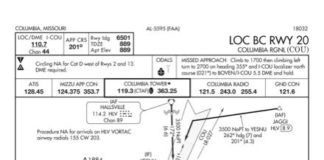The main article covers a lot of things to consider for your various briefings. Here, though, is a view of the items you might want to brief for each phase of your flight.
Route: Do the fixes make sense? How do you get from the runway to the first fix? What’s your initial heading? Is there a charted or obstacle departure procedure? At the destination, is there an arrival procedure? How do you get onto the approach? Given the forecast winds, what departure and arrival runways and approach will you likely get?
Altitude: Were you simply assigned an altitude, or do you need to find it on a procedure? Are there intermediate altitude restrictions on the departure? …on the arrival? Can you make them? What planning is required?
Speed: What are your speeds for takeoff and landing, even if they’re the same ones you use every time? Also, fast movers should note any speed requirements or restrictions on the procedures.
Frequency: Have you identified ground, tower, departure and approach frequencies? At larger airports, these can vary with your route, both on the ground and in the air. Do you have the nav frequencies ready?
Transponder: Set your assigned code. Do local procedures require you to taxi with transponder on?
Taxi route: How will you get from your parking to the runway and from the runway to your parking? Are there any hot spots or points of confusion?
Runway: What runway will you use? What’s its length? Is it long enough? What will you do if an (the?) engine fails, both before and after takeoff?
Environment: Where is the terrain you’ll want to know about in case of problems? Which way is the wind blowing? (“I’ll have a right crosswind on takeoff.” “The crosswind from the left will tend to blow me through final, so I’ll have to turn a bit early.”) Will the sun be a factor and do you have visors ready? Are there any NOTAMs affecting the flight?
Weather: What is the current and forecast weather for the flight and what are the weather requirements?
Threats: What risks or threats affect you? What could go wrong and why? What can you do to mitigate each threat.
Each instrument approach should be briefed separately and specifically. Jeppesen and AeroNav facilitate this by putting critical information at the top of the approach chart, but I recommend not using that for your briefing. Instead, ferret out the information from the chart itself to better familiarize yourself with the procedure. Then, use the summary at the top as a final setup check. Approach briefing items include:
- Procedure name and effective date of the chart
- Frequency of the primary and secondary navaids, or a RAIM check for GPS approaches
- A review of the route you’ll take from the enroute environment onto the approach, even if you expect radar vectors
- Wind and/or sun effects on the approach
- Altitude restrictions all the way from enroute to the missed approach, with an emphasis on where you’ll begin your count down to the minimum altitude
- The final approach course
- Location and method of determining the missed approach point
- Minimums, specifically called out for your particular approach variation and aircraft category (“Category B minimums for this approach without identifying fix OPHAW are…”)
- Height above runway for the minimum altitude, and the airport elevation
- The type and location of expected runway lighting
- The missed approach procedure, including route, altitude, navaid, hold and hold entry
- Notes that might apply to you, like, “ADF Required”
- The location and magnitude of terrain or obstacles
George Shanks retired from a major U.S. airline. He now even briefs his drive to work to a corporate pilot training center in Dallas, Texas.




